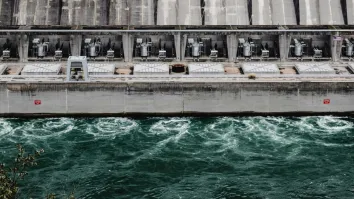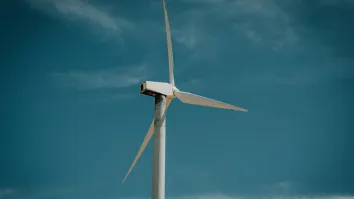
Renewable energy use may become mandatory for some Indian sectors
The bill will impose carbon trading and minimum consumption of non-fossil fuel sources.
When India's government passes the amendments to the Energy Conservation Act of 2001, some sectors in India may be compelled to source their power from renewable energy sources, or else they will be penalised up to INR1m (INR10 lakh) for the failure of compliance.
The Energy Conservation (Amendment) Bill, 2022, or Bill No.177-C of 2022, passed by the country’s lower house in August, will mandate a minimum consumption of energy from non-fossil fuel sources in sectors, which include mining, cement, textile, and transport such as railways, and commercial buildings.
Aside from the INR1m penalty, those who fail to comply may also be liable to an additional penalty not exceeding twice the price of every metric ton of oil equivalent prescribed under the law, which is over the prescribed norms.
“They will have to necessarily meet some of their energy requirements through non-fossil fuel energy. So I think that's the demand side push, which the bill is trying to get by making this obligatory in some of the industries,” Vibhuti Garg, energy economist and director, South Asia at the Institute for Energy Economics and Financial Analysis , said.
Under the proposed measure, the government may specify the standard of processes and energy consumption for appliances, vehicles, vessels, industrial units, buildings, or establishments. Building, under the bill, includes those that have a minimum connected load of 100 kilowatts or contract demand of 120-kilovolt ampere and will be used for commercial, office, or residential purposes.
READ MORE: India renewables to rise by 35-40GW annually
Energy-intensive industries have to get energy audits and submit a report on the status of energy consumption at the end of a financial year to the designated agency. Those who fail to comply will be liable to up to INR1m (INR10 lakh) and may be liable to an additional penalty which may extend to INR10,000 daily for continuing failures, the bill said.
India, which aims to achieve net zero by 2070, pledged to reduce the emission intensity of its gross domestic product by 45% by 2030, from 2005 levels, and have around 50% of its total installed electric power capacity from non-fossil fuel resources at the same period, according to a statement by the Ministry of Environment, Forest and Climate Change.
Fossil fuels accounted for 58.5% of India’s total energy mix, whilst the remaining 41.5% were from non-fossil fuels, data from the Ministry of Power showed as of 30 June 2022. Of the fossil fuels, 50.7% were sourced from coal.
Carbon trading
Another salient feature of the bill is the imposition of a carbon credit trading scheme. Under the proposed measure, the Central Government or any agency it has authorised will issue a carbon credit certificate to a registered entity that complies with the requirements. The registered entity will have the discretion to purchase or sell the certificate.
Garg said the scheme will provide “a lot of impetus” to renewable energy development as most industries, after meeting their own requirements, will trade the excess with other consumers who are struggling to procure or set up their own clean energy alternatives.
“That gives them a lot of scope beyond their own requirements. Carbon trading will kind of incentivise more and more clean energy deployment in the country,” she added.
The bill also prohibits the manufacturing or importing of any equipment, appliance, vehicle or vessel if it does not follow the energy consumption standards.
It has to be approved by the Upper House or Rajya Sabha, and then signed by the president for it to be enacted into law.
Future of fossil fuel
Generally, it is easier for industries to finance their operations that are linked to environmental, social, and governance (ESG) goals, such as the reduction of carbon emissions, Garg said. Indian industry players are also tapping into international financing through ESG pools or green bonds.
Once the proposed measure is passed and there is now demand to meet the obligations for non-fossil fuel use, this will drag down the demand for coal from these industries.
However, Garg noted that clean technologies, combined with storage or green hydrogen remain expensive.
“Over time, when the prices for renewable energy and green hydrogen keep going down, most of these companies or industries will be increasing the share from non-fossil fuel energy and reduce reliance on coal,” she said.
Renewable energy received more funding than coal for the third straight year in 2020, accounting for 74% of the total $3.2b loans during the period, all of which were solar and wind. This is a 6% year-on-year rise from 2019, according to a report by Climate Change and the Centre for Financial Accountability published in December 2021.
Renewables also remain cost-competitive as their prices continue to decline in 2021, with the cost of electricity from onshore wind declining by 15%, offshore wind by 13%, and solar photovoltaics by 13% compared to the previous year.
Achievable target
Garg said reaching 50% by 2030 is “quite achievable” as India has set up huge deployment targets for more renewable energy which include pumped hydro and hydro capacities but it will be largely driven by solar.
On the other hand, Fitch Solution said in a report that India may fall short of reaching its target by 2030 and its renewables will only account for 48% of the total energy mix. It added that the country may also not meet its renewables capacity target of 175GW by 2022.
It noted the announcement by the Secretary of the Ministry of New and Renewable Energy in August that the country will fail to meet its 60GW wind installed capacity target by year-end and its overall renewables target.
“We believe the bill is an effort to accelerate renewables growth over the coming years as it will mandate the consumption of electricity generated from non-fossil fuel sources, increasing renewables adoption,” it said.
“We still maintain our growth forecasts for India’s non-hydropower renewables growth, as the amendment proposal does not state any mandated percentage of renewable electricity consumption. The market’s non-hydropower renewables will grow at an annual average of 9.3%, from 100GW at end-2021 to 242GW in 2031,” it added.



















 Advertise
Advertise






